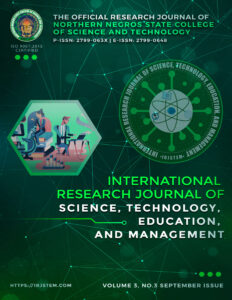September 2023

The correlation between university students’ interactions and their character development in Morocco
Ayman Belhiyad
Sidi Mohamed Ben Abdellah University, Morocco
Full Paper PDF Abstract 1-12
Teachers’ beliefs and challenges of using multimedia for teaching visuals in social work: A study of Bangladeshi government college
Md. Habibul Ahasan
Assistant Professor, Department of Social Work, Bhola Government College, Bhola
Affiliation with the National University of Bangladesh
Full Paper PDF Abstract 13-23
Improving grade five students’ recreational reading habits: An action research
Lobzang Cheki, Karma Rinzin, Pema Desi, Yeshi Yangtsho, Sonam Gyaltshen
Chumey Higher Secondary School, Bumthang, Bhutan
Full Paper PDF Abstract 24-34
Assessment of environmental law awareness and pro-environmental behavior among DEBESMSCAT- Cawayan Campus Agriculture students
Roger Y. Ibanez, Jr., Jacob Frederick P. Velza, Alvin M. Mahawan, Jonna Mae B. Catimpuhan, Restiel V. Gaylan
Faculty, Institute of Agriculture, Cawayan Campus, Dr. Emilio B. Espinosa, Sr. Memorial State College of Agriculture and Technology, Cawayan, Masbate, Philippines
Faculty, College of Education, Dr. Emilio B. Espinosa, Sr. Memorial State College of Agriculture and Technology, Mandaon, Masbate, Philippines
Student, Institute of Agriculture, Cawayan Campus, Dr. Emilio B. Espinosa, Sr. Memorial State College of Agriculture and Technology, Cawayan, Masbate, Philippines
Full Paper PDF Abstract 35-43
Perceived support from the organization as a mediating variable between high performance work systems and creativity of employees
Rashed Mahmud Shakil, Md. Nizam Uddin, Jannatul Ferdous, Md. Sorowar Hossen
Department of Business Administration, Uttara University, Bangladesh
Department of Business Administration, BGC Trust University Bangladesh, Bangladesh
Full Paper PDF Abstract 44-55
Effects of flipped classroom teaching strategy on pupils’ motivation and achievement in numeracy in nursery schools in Abuja, Nigeria
Muraina Kamilu Olanrewaju, Ojonugwa D. Solomon, Oladele Omolara, Olayemi Zainab Oduola
Prince Abubakar Audu University Anyigba, Nigeria
Federal University of Health Sciences, Osun State
Full Paper PDF Abstract 56-63
Improving the functionality, 5S rating, and inventory management system of the supply department of a regimental academy in the Philippines through industrial engineering applications
Geraldine G. Nerona, Jorina R. Bohol, Kyla Nicole R. Decena, Jonathan N. Jose, Anjelika N. De Guzman, John Carlo R. Rodriguez, Kate Shyra M. Abiado, Mark Christian O. Aquino, Sandra Nicole L. Antolin, Nicole Ivy G. Kalaw, Anne Claire N. Paulino
Department of Industrial Engineering/Saint Louis University, Philippines
Full Paper PDF Abstract 64-78
Environmental friendly decorative electroless copper plating on Acrylonitrile Butadiene Styrene plastics
Aung Than Htwe, Thet Mar Wint, Zayar Lin Myint
Department of Chemistry/University of Yangon, Myanmar
Department of Chemistry/Mohnyin University, Myanmar
Department of Chemistry/Sittway University, Myanmar
Full Paper PDF Abstract 79-87
Students’ perception of community as classroom for learning Geography in middle secondary school
Karma Sonam Rigdel , Mani Raj Thapa
Wangbama Central School, Ministry of Education and Skills Development, Bhutan
Jigme Namgyel Lower Secondary School, Ministry of Education and Skills Development, Bhutan
Full Paper PDF Abstract 88-102
Enhancing operational efficiency and financial reporting through Oracle NetSuite ERP implementation: A case study in a logistics company
Stepani Sisca Wulandari, Kevin Maulana
Perbanas Institute, Indonesia
Full Paper PDF Abstract 103-121

